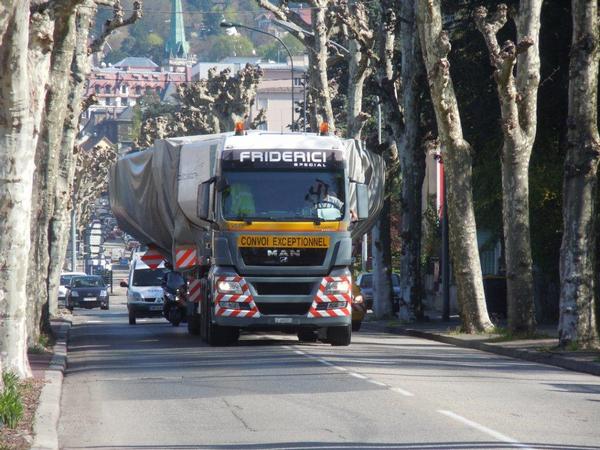EPFL takes on the Vendée Globe in Bernard Stamm's wake

Rivages, just before going out of the boatyard Décision, last week. © Alain Herzog
The navigator from the Swiss canton of Vaud is working with EPFL to equip his new boat, Rivages, designed for the Vendée Globe 2012. Rolled out of the Décision shipyard in Ecublens last week, this monohull measuring nearly 20 meters will be christened at La Ciotat (France) this weekend.
Only a small hill called Motty, in Ecublens, divides EPFL from Bertrand Cardis’ Décision boatyard. This geographical proximity is amplified by many technical, scientific and even emotional affinities. Rivages, the Vaud navigator Bernard Stamm’s sleek new sea-creature, will add a new chapter to the nautical history of the EPFL laboratories.
Thanks to support from the Sandoz family’s Foundation, which owns the boat and has special ties with our school, EPFL has brought its expertise to bear in several areas and benefited from productive interaction with the navigator’s technical team. The work involved to optimize the boat’s component materials, for example, were carried out at the Laboratory of Composite and Polymer Technology (LTC), with the objective of meeting the construction requirements as closely as possible.
The sails in real time
As well as taking this “scientific advisory” role in the actual construction, several teams from EPFL are continuing to follow Bernard Stamm’s adventures in real time. The Computer Vision Laboratory (CVLAB), in cooperation with the company Space3D, has already installed many cameras on the boat. It will now add some more cameras to observe the sails and model their movements in three dimensions and in real time, to gain a better understanding of the wind-flow patterns and to optimize their adjustments.
Some other experiments, in particular oceanographic, will be conducted on board. Their interest therefore extends well beyond the sailing world itself. The Audiovisual Communications Laboratory (LCAV), which had already developed the environmental sensors for the SensorScope project, is currently working to produce the lightest possible “minilab”. On the hour, this will take a sampling of water, to make an automatic analysis of several parameters (temperature, salinity, oxygenation, turbidity, and micro-organism content) that it will transmit to land-based centers. Oceanopolis and the CNRS will be able to use the findings immediately as part of a specific study of micro-plankton, and these will also be made available to the scientific community. “The race uses routes that are rarely followed around the Antarctic, so it is an excellent opportunity to collect rare and detailed data and compare them with the measurements obtained by satellite”, explains Guillermo Barrenetxea, a scientist working at LCAV.
Energy needs
A high-tech boat like Rivages needs more than a little wind and fresh water. The extensive electronic equipment required for navigation and – in this case – for all the scientific tasks need electricity. How can it be produced on-site and be managed optimally without weighing down and braking the boat? The Industrial Electronics Laboratory (LEI) is working to find the best solution. As Philippe Barrade, First Assistant, sums it up: “We must not only optimize the instruments to make them more energy-efficient, but also develop an intelligent system to manage the use, the reserves and the battery recharging system”.
Solar cells, wind and water turbines and a diesel generator are the main candidates for supplying electricity. A combination of these sources will have to meet all the boat’s needs without making too many demands on the skipper’s attention. “Our energy production and management systems will therefore need to be extremely reliable”, adds Philippe Barrade.
On 11 November 2012, at Sables-d’Olonne, the starting-boat will give the signal for the Vendée Globe race to begin – this legendary solo race with no stopover or assistance. An impressive 60-foot monohull curved like a seagull, Rivages will then launch its assault on the southern seas.
Eighteen months in preparation
For the moment, Rivages has just undergone a long voyage by special convoy to La Ciotat, near Marseille, where it arrived yesterday. And this weekend it will receive the traditional dose of champagne as a christening, as well as its mast, its sails and all the equipment still to be added. It will make its maiden voyage at the beginning of May, flying the colors of its sponsor “Cheminées Poujoulat”, and will complete several practice races this year (Tour de l’Europe, Transat Jacques Vabre).

These are 18 months of preparation that will be useful both to the navigator and his team, but also to the scientists involved in the project. “This partnership will enable us to advance in many fields”, Bernard Stamm comments happily. “As well as collecting important data, we will be able to improve the boat’s reliability and performance.” At EPFL, the impact of this major project is also being emphasized: “Solving practical questions concerning such a spectacular achievement is highly motivating for both the scientists and the students”, declares Pascal Vuilliomenet, in charge of the Strategic initiatives for the Vice-Presidency for Innovation and Valorization.